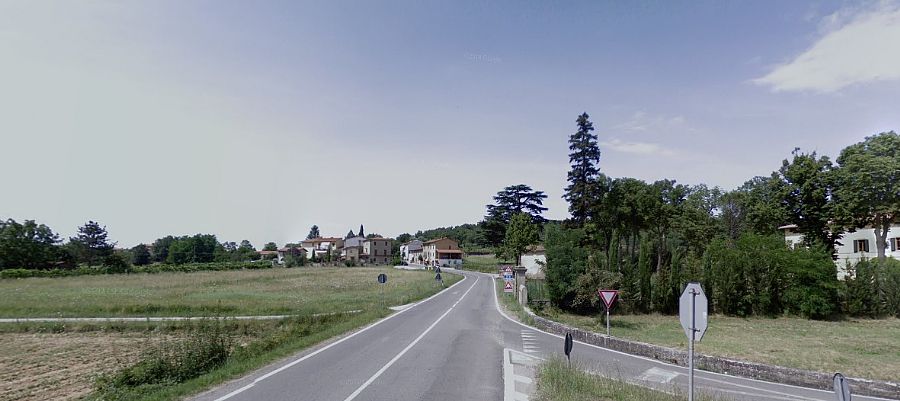Civitella in Val di ChianaLoretta Gallorini

Civitella in Val di Chiana is situated between the Val d'Ambra and the Valdichiana, on one of the highest hills in the area. It is surrounded by woodland and strips of arable land forming terraces on the slopes leading up to the town.
It has been carefully conserved and is perhaps one of the best examples of the small Longobard fortified towns built to oversee central Italy between the 6th and 7th centuries. The walls are almost intact and form a perfect oval, typical of military outposts of this kind. They link up at the top of the hill, on the west side close to the "Rocca" (stronghold), a fine 2nd century building.
Enter the town by what was the Aretina gate which was built in the 13th century during the tenure of Bishop Guglielmino degli Ubertini. The gate together with some ancient turrets nearby, was destroyed during World War II.
Take via San Francesco and follow the ancient walls until you reach Piazza Lazzeri where a bronze monument by Mario Moschi commemorates the tragic execution in the piazza, of 176 people during the second world war.
Close to the monument is the church of Santa Maria, first built in the year 1000. Originally built in Romanic style, it has been enlarged and altered through the centuries. The Bell Tower was destroyed by bombs during the war and has since been rebuilt. In the centre of the simple façade built in traditional Tuscan stone, is a splendid bronze door by the contemporary Florentine artist Bino Bini. Inside there are three naves. A series of arches, rebuilt after the war, lead from the central nave to the apse. Also of interest are the large 20th century windows by various artists. In the right hand nave, beyond the vestry, there is a painting by the artist Teofilo Torri of Arezzo entitled "Crocifissione tra I Santi Niccolò di Bari, Giovanni Battista, Caterina and Maria Maddelena" dated 1602.
Also in Piazza Lazzeri is Palazzo Ninci a series of buildings which, during the 18th century, were joined together to form the present palazzo. At the end of the square, before entering via Martiri della Libertà , lies a medieval cistern "La Cisterna", which was the hub of the town for centuries. With no water sources inside the town, the cistern and the rainwater it collected was essential for the survival of the community. Octagonal in shape and with five steps at its base, it was built in the 18th century.
Entering via Martiri della Libertà, on the right hand side is the school and an open gallery "Il Loggiato". The building was once the town's chancery and later became the Town Hall. Today the building houses the post office, a "memorial room" set up by the families of the victims of the wartime execution, and a series of exhibition rooms. "Città di Civitella" a painting exhibition with awards is held here every two years.
Enjoy a pleasant walk along via Martiri with its 15th century arcade. At the end, on the right hand side, is Palazzo Pretorio, the seat of the chief magistrate after the year 1384. The original building must have been very similar to the present one and facing the main road there must have been a public gallery. The remains of the two arches are to be seen under the arcade and on the wall are the glazed ceramic coat of arms of the magistrates. Inside, in the Audience Chamber, there is a fresco depicting the "Maesta" between two saints, probably Saint John and Saint Biagio. On the right in Piazza Becattini, is a series of mediaeval buildings which form Palazzo Becattini. The Palazzo was rebuilt in 1800 but the remains of the walls of the original building are visible at the back, and on the side facing la Rocca. A short detour passing between the two "palazzi" leads to a terrace with a splendid view of the Val d'Ambra.
Leaving piazza Becattini a short climb takes you to the Rocca with its defending walls and single gateway. It is a classic example of a medieval castle, the walls form a perfect square and the keep is built in the west facing corner. The decorative elements make it a fine example of fortress architecture, the doorway with its pointed arch, the window with its longiinal arch, the quality of the materials used and other refined technicalities, make it unique of its kind for the era.
Back in the town, walk along via Nuova until you reach the crossroads with via di Mezzo where you will find a tabernacle containing a coloured majolica statue of the Madonna and Child of the Robbiana school dated 1522.
Further on, at the opposite side of the town to the Aretina gate is the Senese gate. It was built in the 13th century using large, square stones, and can be admired today, exactly as it was then. Return either by via di Mezzo or via della Costarella taking in the mediaeval charm of this Tuscan town and admiring the view of the Valdichiana from piazza Mazzini.
Browse carefully selected vacation home rentals in Civitella in Val di Chiana.

 Amalfi Coast
Amalfi Coast Sorrento Coast
Sorrento Coast Tuscany
Tuscany Cilento National Park
Cilento National Park Lake Como
Lake Como Rome and Latium
Rome and Latium Umbria
Umbria Capri and Ischia
Capri and Ischia Venice
Venice Puglia (Apulia)
Puglia (Apulia) Liguria
Liguria Sicily
Sicily Lake Maggiore
Lake Maggiore Lombardy
Lombardy Sardinia
Sardinia Lake Garda
Lake Garda Abruzzo and Marche
Abruzzo and Marche Calabria
Calabria

